Stanley Kubrick’s ‘The Shining’: American Deterioration Through Americana
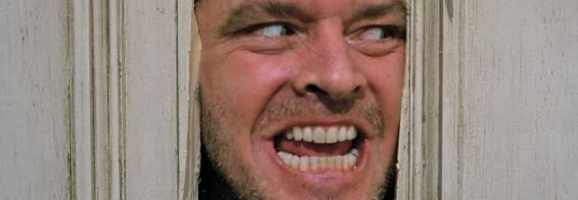
The third Monday in February marks the annual federal holiday of Presidents’ Day (or, Washington’s Birthday) in the great ‘ol US of A. The holiday is steeped in patriotism as it celebrates the founding fathers and leaders of the U.S. Though, admittedly, it’s more so become a day that kids only care about because they don’t have to go to school, and some adults don’t have to go to work. But regardless of what the meaning of the day is becoming, there’s still an inherent sense of nationalism tied to the holiday. And with its impending annual arrival, it got me thinking about the ways America is represented in film, particularly one of my favorite films, The Shining. Kubrick represents a side of America that needs to be discussed by tying it to themes that recur throughout the film.
In The Shining, Stanley Kubrick creates a frightening story of the deterioration of American society through national self-reflexivity, that is, Kubrick depicts different elements of Americana to portray a commentary on American culture. Within the film, we can see that racism, classism, and the breakdown of the nuclear family are being presented as indictments of American culture. But it is the way in which Kubrick presents them that is rather ingenious. In order to elucidate issues of race, class, and family, Kubrick introduces them through verbal and visual, quintessentially American histories, images, and colors. It is with these elements of traditional Americana that Kubrick commentates on American societal deterioration.
From start to finish, an inherent racism is prevalent in The Shining. At the root of this racism is the fact that we learn the Overlook Hotel is built on an ancient, Indian burial ground. But it is the story behind the construction of the Overlook that ties its racism to American historical culture. With mild joviality in his voice, Ullman, the manager of the Overlook, tells Jack and Wendy that there were fights to fend off Indian attacks during the construction of the hotel. Speaking in the most blasé way possible, Ullman conveys the story of Native American sufferings at the hands of this hotel as trivial. What we see here is Kubrick using American history to show the racism ingrained in the Overlook, which in turn causes the audience to examine their own racial prejudices.
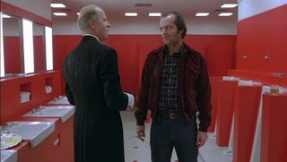 One of the most blatant examples of racism is when Jack is having a conversation with the ghost of the former caretaker of the Overlook, Grady. In this conversation (seen in the following image), Grady informs Jack that Jack’s son, Danny, is trying to bring an “outside” party into the situation at the Overlook. This outsider is the black chef at the hotel, Halloran. Grady refers to Halloran as “a nigger.” There is overt racism in the speech, but it is tied to American society through Kubrick’s choice of mise en scène. The colors red, white, and blue factor predominantly into this scene (and recur throughout the entirety of the film). The walls are vividly red. The bathroom fixtures and floor are bright white. And in the center of it all is Jack’s all-American blue jeans. Incorporating this particular element of Americana (i.e., patriotic colors) into such a racist scene implicates American society, through association, with racist ideals, which Kubrick implies is a factor contributing to a deteriorating society. He does so, as Greg Smith mentions in his essay “‘Real Horrorshow’: The Juxtaposition of Subtext, Satire, and Audience Implication in Stanley Kubrick’s The Shining,” by portraying the two black characters, Hallorann and Hallorann’s service station worker friend, Larry Durkin, as the only positive, adult male characters in the film (301-302). All the white, adult male characters in The Shining are deplorable and lack any redeeming qualities.
One of the most blatant examples of racism is when Jack is having a conversation with the ghost of the former caretaker of the Overlook, Grady. In this conversation (seen in the following image), Grady informs Jack that Jack’s son, Danny, is trying to bring an “outside” party into the situation at the Overlook. This outsider is the black chef at the hotel, Halloran. Grady refers to Halloran as “a nigger.” There is overt racism in the speech, but it is tied to American society through Kubrick’s choice of mise en scène. The colors red, white, and blue factor predominantly into this scene (and recur throughout the entirety of the film). The walls are vividly red. The bathroom fixtures and floor are bright white. And in the center of it all is Jack’s all-American blue jeans. Incorporating this particular element of Americana (i.e., patriotic colors) into such a racist scene implicates American society, through association, with racist ideals, which Kubrick implies is a factor contributing to a deteriorating society. He does so, as Greg Smith mentions in his essay “‘Real Horrorshow’: The Juxtaposition of Subtext, Satire, and Audience Implication in Stanley Kubrick’s The Shining,” by portraying the two black characters, Hallorann and Hallorann’s service station worker friend, Larry Durkin, as the only positive, adult male characters in the film (301-302). All the white, adult male characters in The Shining are deplorable and lack any redeeming qualities.
Within the aforementioned racial tensions, issues of American classism also become illuminated. When Ullman is telling the story of the removal of the Indians, we are left to realize that the “other” does not matter in this situation if, in their place, is a showy, grand display of American (white) bourgeois opulence — in this case, the grandeur of the Overlook Hotel. Class trumps all, and the Overlook caters to the upper-crust of society, which is seen as more important than the “other.” Also, when Grady is speaking to Jack and calls Hallorann “a nigger,” he further specifies and calls him “a nigger cook.” It is understood that the use of the word “cook” is definitely meant derogatorily. Calling him a cook establishes a social ladder based on American classism. Amongst the traditional, upper-class guests at the Overlook, Hallorann ranks as completely insignificant as a lowly cook.
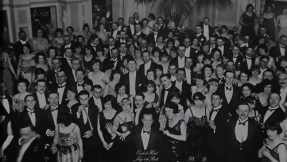 The film ends displaying American racism and classism through the black and white photograph (seen in the image to the right) of Jack and the other guests during a ball at the Overlook. The racism behind this picture is the fact that no black men or women are pictured; this is strictly a party for the white members of society. The picture then goes further into realms of classism. Not only are blacks excluded, but this party is only for the well-to-do white members of society. We can see that Kubrick is using this photograph to show the deterioration of American society through Americana because he explicitly links the picture to American culture through the date of the party — July 4th, 1921. By so closely linking a date that is arguably the most important in American culture, Kubrick is implicating the audience of being guilty of these things.
The film ends displaying American racism and classism through the black and white photograph (seen in the image to the right) of Jack and the other guests during a ball at the Overlook. The racism behind this picture is the fact that no black men or women are pictured; this is strictly a party for the white members of society. The picture then goes further into realms of classism. Not only are blacks excluded, but this party is only for the well-to-do white members of society. We can see that Kubrick is using this photograph to show the deterioration of American society through Americana because he explicitly links the picture to American culture through the date of the party — July 4th, 1921. By so closely linking a date that is arguably the most important in American culture, Kubrick is implicating the audience of being guilty of these things.
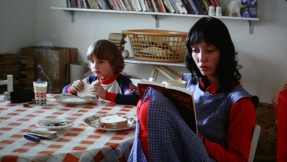 It is not only issues of race and class in America that Kubrick challenges in The Shining. One of the most important elements of the film, I would say, is the deterioration of the American family ideal. And just as with racism and classism, Kubrick depicts the breakdown of the nuclear family by using traditional American items and images. Though we do not necessarily know it yet, one of the first instances of the deterioration of the nuclear family in this film occurs when Wendy is talking to Danny in the kitchen about going to the hotel (seen in the above image). Danny (speaking as Tony) says he does not want to go to the hotel. We understand this to mean he knows something bad is going to happen. This forewarning of bad things to come is emphasized by the recurrence of the red, white, and blue color scheme, this time in Wendy and Danny’s clothing. But also, there is a baseball behind
It is not only issues of race and class in America that Kubrick challenges in The Shining. One of the most important elements of the film, I would say, is the deterioration of the American family ideal. And just as with racism and classism, Kubrick depicts the breakdown of the nuclear family by using traditional American items and images. Though we do not necessarily know it yet, one of the first instances of the deterioration of the nuclear family in this film occurs when Wendy is talking to Danny in the kitchen about going to the hotel (seen in the above image). Danny (speaking as Tony) says he does not want to go to the hotel. We understand this to mean he knows something bad is going to happen. This forewarning of bad things to come is emphasized by the recurrence of the red, white, and blue color scheme, this time in Wendy and Danny’s clothing. But also, there is a baseball behind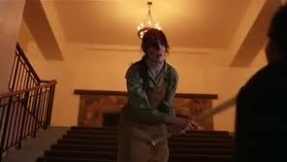 Danny’s head, creating a physical manifestation of a classic American pastime, the sport of baseball. It should be noted, then, that it is no coincidence when the nuclear family deterioration has fully occurred when Jack wants to kill Danny and Wendy, Wendy’s weapon of choice is a baseball bat (seen in the image to the right).
Danny’s head, creating a physical manifestation of a classic American pastime, the sport of baseball. It should be noted, then, that it is no coincidence when the nuclear family deterioration has fully occurred when Jack wants to kill Danny and Wendy, Wendy’s weapon of choice is a baseball bat (seen in the image to the right).
Another way the nuclear family is shown as deteriorating is through discussion and images of the quintessentially American television. Everything revolving around TV in The Shining seems to bring out negative aspects of the family. On the way to the hotel, the Torrances are having a conversation in the car. The only time in the film when Jack shows any pride in his son is during this conversation when Danny says he knows what cannibalism is because he learned about it on television. We get the sense that something is not right with this family if the father is only proud of his son for knowing what cannibalism is. In a later scene, Danny is seen watching TV right before he has an odd conversation with his father, in which Danny asks Jack if Jack would ever hurt him or his mother. Later, Danny is watching a Road Runner and Wile E. Coyote cartoon, highlighting the similarities in the way Jack is essentially hunting his family.
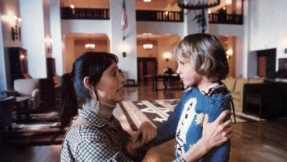 The depiction of the deterioration of the nuclear family continues right after Danny has been attacked, presumably by the ghostly woman in the bathtub in room 237. Kubrick really plays with elements of Americana in this scene to get across the point (as seen in the image to the right). Danny has just been attacked, his Apollo 11 sweater torn and tattered. The shredded American icon (i.e., the picture of Apollo 11) that Danny is wearing is symbolic of the young boy’s innocence being taken from him due to a situation in which his parents have put him. This takes place immediately proceeding Jack telling Wendy he has just dreamt that he killed his family. The American Flag in the background of all of this is of notable mention.
The depiction of the deterioration of the nuclear family continues right after Danny has been attacked, presumably by the ghostly woman in the bathtub in room 237. Kubrick really plays with elements of Americana in this scene to get across the point (as seen in the image to the right). Danny has just been attacked, his Apollo 11 sweater torn and tattered. The shredded American icon (i.e., the picture of Apollo 11) that Danny is wearing is symbolic of the young boy’s innocence being taken from him due to a situation in which his parents have put him. This takes place immediately proceeding Jack telling Wendy he has just dreamt that he killed his family. The American Flag in the background of all of this is of notable mention.
But perhaps the most conspicuous examples of the deterioration of the nuclear family in The Shining are the actual acts of heinous, violent attacks taken out on family members. It is not only evident in the case of the Torrances, but also in the case of the Gradys. The connections to these specific acts of violence and American culture are twofold: their connection to American culture is through words and through colors. When Jack is coming to attack Wendy and Danny, Smith writes about the language that Jack chooses to use in this moment, connecting it to American television, the epicenter of negativity for this family as I have mentioned earlier. In his essay, Smith says:
‘Wendy, I’m home,’ [Jack] calls amiably upon chopping through the first door, with that one phrase recalling the banal entry cue of countless American white male sitcom fathers from the 1950s, along with associated images of the ridiculous television idealizations of the nuclear families they headed. ‘Heeeeere’s Johnny!’ he announces dementedly when he manages to whack a sizeable hole in the bathroom door, now aligning himself with the comedic king of American late- night television who, it should not go unnoted, is well known for being unable to cultivate a successful marriage. (303)
Taking these clear staples of American culture and setting them against a scene of such gory violence is to definitely make obvious the connection of the deteriorating American family by using American culture to prove that point.
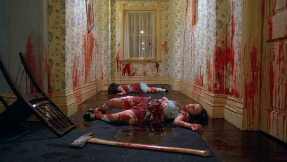 In this violence, we see the return of the red, white, and blue theme. Kubrick using Jack’s Americana-heavy dialogue during the scene of graphic familial violence served a verbal and auditory purpose. The recurrence of the patriotic color scheme in the graphically violent scenes serves a visual purpose. Grady greatly emphasizes to Jack how he “corrected” his family and Jack’s need to “correct” his family, too. At one point in the film, we see the results of Grady’s “correcting” (seen in the image to the left). This is a horribly graphic image in which we see the ultimate breakdown of the nuclear family. Grady has taken an axe to his two young daughters leaving their lifeless bodies in pools of blood. To show this familial deterioration, Kubrick uses the red of the blood, the white of their skin and the woodwork on the walls, and the blue of the girls’ dresses to connect this decay to American culture.
In this violence, we see the return of the red, white, and blue theme. Kubrick using Jack’s Americana-heavy dialogue during the scene of graphic familial violence served a verbal and auditory purpose. The recurrence of the patriotic color scheme in the graphically violent scenes serves a visual purpose. Grady greatly emphasizes to Jack how he “corrected” his family and Jack’s need to “correct” his family, too. At one point in the film, we see the results of Grady’s “correcting” (seen in the image to the left). This is a horribly graphic image in which we see the ultimate breakdown of the nuclear family. Grady has taken an axe to his two young daughters leaving their lifeless bodies in pools of blood. To show this familial deterioration, Kubrick uses the red of the blood, the white of their skin and the woodwork on the walls, and the blue of the girls’ dresses to connect this decay to American culture.
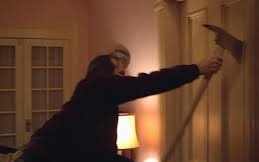
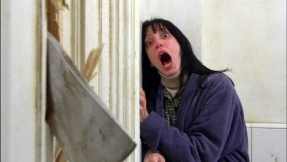 And this color scheme continues when Jack is trying to attack Wendy and Danny in the bathroom with an axe (seen in the above left and right images). The blue of Wendy’s robe, the stark white bathroom walls and tiles, and Jack’s red coat come together to form the same connection as previously mentioned, all while Jack is carrying out a murder attempt on his son and wife. And even more red is introduced when Wendy slashes her husband’s hand and he bleeds from the wound.
And this color scheme continues when Jack is trying to attack Wendy and Danny in the bathroom with an axe (seen in the above left and right images). The blue of Wendy’s robe, the stark white bathroom walls and tiles, and Jack’s red coat come together to form the same connection as previously mentioned, all while Jack is carrying out a murder attempt on his son and wife. And even more red is introduced when Wendy slashes her husband’s hand and he bleeds from the wound.
Creating a film that also serves as a social commentary on our society is nothing new. But Kubrick does this in a brilliant way by using our own culture to show how racism, classism, and the deterioration of the nuclear family are negatively affecting our society. Smith says:
…it is no surprise that Kubrick, a director who indulges his penchant for using mirrors as cinematic devices in The Shining, ultimately suggests that his film is horrific not because it’s about ghosts, but because it reflects us, its audience, as Americans. (300)
When we watch the horror that is taking place in the film, we are really watching the horror of our deteriorating society. When we watch the racism, classism, and familial breakdown in the film, it is really our own struggles with these issues that we are watching. It is brilliant of Kubrick to use elements of Americana, from American history, to baseball, to the patriotic colors of the country, to construct a narrative of the decline of our society. There is still a ways to go to fully correcting these issues of American society, but by Kubrick directly implicating us in these issues, it causes us to take a deeper look at them, which is the first step in eradicating such negative aspects from our culture.
What do you think? Leave a comment.











Good post. Kubrick’s films are marvels of construction and obsessive attention to detail, but this is also the reason that they often come across as brilliant but cold.
Have to agree and have said it for a long time. Kubrick’s films are always technically very good & often innovative, but often lack “soul”. A prime example is Barry Lyndon, which beyond suffering the woeful miscasting of Ryan O’Neal in the titular role, has something missing that prevents you from being fully drawn in to it. Obviously that is my personal opinion.
I see your point but I think those films do have a soul, albeit even if the bleakness of the human condition is what is covering it up and ultimately therefore it is about the search of destroying the soul.
Although I do love Barry Lyndon but I understand any criticism towards it and I have to confess I am a sucker for period drama anyway.
The problem with Kubrick is he seems to lack empathy with his characters, and The Shining’s major flaw is there is virtually no one to root for. Danny is simply weird and disengaged, Jack is a loony from just about the start and Poor old Wendy is a bit annoying and then simply runs away and screams in the second half (most of the positive attributes she possesses are inherited from the rather more forthright and self possessed character in the book).
Just about the the only really relatable character in the film is Dick Hallorann, and look what Kubrick did to him.
Genre wise, Kubrick was a bit of a dilettante, moving between genres as he saw fit, though he made more war movies than anything (depending how you count Barry Lyndon).
I went to a London Cinema to see “The Shining” within its first few weeks of UK release. I sat through it all in total boredom, waiting for the good parts to begin. They never did. I don’t think I have ever been so bored in all my life. It was an absolutely appalling film with not one single redeeming quality. The acting was amateur, the plot virtually non-existent, the character motivations inexplicable, the dialogue banal, the directing sleep-walking, the length at least an hour and a half too long, the music dreadful. In the “Independent” (25th October) there’s a headline: “Did Stanley Kubrick Fake the Moon Landings”. I would say NO, because the Moon Landings were worth watching.
This is actually a good tribute to this movie. Even more than 3 decades after its original release “The Shining” (at least to me) is still as genuinely creepy and terrifying today as it was back in 1980. The cinematography in the film is absolutely amazing, and the music score (especially during the opening pan across the landscape) is amazingly great. The scenes in the hotel still have the same surrealistic terror to them as they did back then, and still have the ability to make you either jump or cringe. the performances are all amazing; Jack Nicholoson was incredible, so funny and so evil at the same time. A lot of people say Shelly Duvall was annoying, but i thought she made a great Wendy, and really captured the terror and depth of her character as well. the kid who played Danny was amazing too. Personally, i think this film has aged incredibly well, an will continue to get better with age. Definitely a classic worth revisiting again and again.
It’s probably not the popular opinion, but Stephen King is an awful writer and a fool for not seeing how well the film works. For me, Nicholson’s performance increased the tension of the entire movie without relying too much on the supernatural. There’s nothing wrong with an overtly supernatural story, but Kubrick chose to focus more on the human danger.
I don’t think King is an awful writer, but I absolutely agree with your opinion on his view of the film. I’d be honored if Kubrick directed one of my novels…
Much like Nilson, I can’t agree that King is an awful writer, but I wholeheartedly agree that his criticism of the film is rather harsh. I think in his observation of the film, King missed some crucial elements, and didn’t fully grasp or fully appreciate that Kubrick wasn’t trying to make the film exactly like the novel. I also assume King’s criticism has something to do with the fact that he probably inherently wasn’t going to like anything as well as his own novel.
What do you think of the Overlook’s Native American decor in some of the rooms? Perhaps Kubrick is highlighting the cultural approbation many Americans partake in ignorantly. Many people celebrate St. Patrick’s Day or paint themselves as sugar skulls on Halloween without understanding the significance or origins of the holiday and its traditions.
The film’s portrayal of Jack may highlight the fraying edges of the perfect nuclear family. In the novel, Jack is much more sane and likable at the beginning of the story. His journey from troubled father to crazed killer was terrifying because Jack Torrance could have been anyone’s father. However, Kubrick’s Jack is a bit off from the start of the film. He sets your teeth on edge from his first appearance and it is hinted he is unstable and violent. Kubrick’s Jack has already begun his transformation into a monster. The family was falling apart from real problems (alcoholism, job loss, child abuse) and did not need a haunted hotel to destroy them. It seems to me that the Torrance family in King’s novel had a chance to fix their unraveling lives. In Kubrick’s version, there does not appear to be any hope for the family to heal.
I think your observations of the Native American decor are quite similar to how I would interpret them. It’s also important to note the Native American figure on some of the canned food in the pantry. It becomes quite obvious in the background when Jack has been locked in the pantry by Wendy. I would argue that there is something in setting Native American images against Jack’s complete insanity — and Jack in the pantry highlights just one of his many insane moments.
Kudos–you have generated a provocative explication of a very complex film. In particular, your extensive discussion of TV as a signifier of degenerate American values does score several compelling points, and several other key examples you cite have television connections as well: for instance, by the mid-1980s, baseball had become inextricably linked to television, and the Apollo moon landing, referenced via Danny’s sweater, was (in)famously televised. Moreover, your parodic juxtaposition of Danny/Road Runner against Jack/Wile E. Coyote is quite astute. Given the connections you draw between TV and nuclear-family decadence, is it possible that the idealized American nuclear family model is Kubrick’s primary, rather than secondary, target? Your reading of the film suggests that it may well be so. In other words, the foundational racism and genocide of indigenous peoples that you believe Kubrick’s film tries to foreground seem somehow inherently linked to the family unit, the primary preserver and perpetuator of the very American identity Kubrick exposes to critique.
Thank you! Yes, I would say that the model of the American nuclear family is Kubrick’s primary target (though obviously I don’t know that definitively). In the novel, the Torrances have some redeeming qualities. It’s been a while since I’ve read it, but I even believe at one point Jack, in the novel, actually tries to fight his urge to kill Danny and tries to help them escape. In the film, it is quite hard to find any redeeming qualities. I think Kubrick took his reading of the novel and put on film what he thought was occurring in American society, using the novel to create his own commentary about it.
Very strongly written. I remember the first time I watched ‘The Shining’ I just kept wondering if it meant more than what the camera was showing us, and I think this article did a great job in elaborating the meaning of the film.
Thank you!
Fantastic article. I have not seen The Shining in a long time. After reading this article, i am going to re-watch it with your ideas in mind.
Thank you! I’m glad I could re-spark an interest for you.
Great article, I really enjoyed the analysis on the bathroom scene in particular. As a Kubrick fan, I know a lot has been said on the whole film in general but you definitely brought in some refreshing ideas. Noticing the dialogue about an outsider was brilliant, as well as bringing the character of Halloran’s friend who is often forgotten. Im curious though about what you think about the scene where Danny watches television before going to talk to Jack, in Room 237 it is said that there is no cord from the TV set, I was wondering if you had any theories. The zooming out is strikingly reminiscent of the camerawork in A Clockwork Orange, where Alex is the center of the frame and then a few scenes later it is the artwork in the abandoned building that is centered. In here, I had the sense that not a character or classical art is being shown as dominant, but the TV, showing the odd importance it has in society. Either way, this was a great article and I always love knowing that movies can be written about for thirty years and still be stimulating.
Thanks, Robert, for this really fascinating essay on THE SHINING and its themes of deteriorating Americana. The point you make regarding Grady’s racial and class prejudices is key, and especially in relation to the July 4th photograph, which only emphasizes the entrenched sense of racial privilege in America for much of the 19th and 20th centuries.
In some ways I think Kubrick is savagely mocking that culture and way of life–the white, leisure class of mid 20th century America, “the resort set” (and of course what better way to debunk the myth of that culture than at a fabled ski resort in picturesque Mount Hood?).
I wonder what you think of the inspiration Kubrick drew from Diane Arbus’ famous 1967 photo of the identical twin girls which inspired the look for Lisa and Louise Burns? http://en.wikipedia.org/wiki/Identical_Twins,_Roselle,_New_Jersey,_1967
It seems to me that Arbus’ images have that quality that Kubrick was going for in the movie–the subtle dread that lurks underneath the surface of classic American archetypes.
Fascinating insight…Kubrick is an artistic genius. This demonstrates how much a filmmaker can add to the meaning of an already established story…it is not simply a retelling through a new medium, but a story with entirely new implications. “real horrorshow”, A Clockwork Orange reference?
Kubrick’s genius is to take space-time – which we all take for granted because we live in and through it – and tilt it just ever so slightly slightly off-kilter. Spatially, he does this in The Shining through placing walls where they could not exist and windows where they could not exist, and through the deliberate oddness of continuity ‘errors’ like the shapeshifting typewriter and the disappearing and reappearing chair. This is a game of three-dimensional chess (chess was, intellectually, Kubrick’s first love) through which the cultural commentary is threaded like the shifting pattern of strategies in a chess match. But perhaps the best thing about The Shining is that, for all its ghostly and bloody thumps and rattles, it stays so light on its feet. A comedy in the classical sense (in that it has happy ending), it is also a comedy in the everyday sense, with the villain frozen in the middle of the hedge maze (literally) in a cartoon-like parody of the dog-like grimace he has worn since going mad half way through the movie. The Shining finds and stays so brilliantly in that sweet spot between seriousness and play. Like the bone in 2001 A Space Odyssey, which fades into the cigar-shaped space craft, the inherent problems of the human condition and of being-in-the-world are something Kubrick playfully throws up in the air to see where they will land on the chessboard. Kubrick never projects despair, he projects a very serious kind of playfulness. He says “there it is, look at it, look at what I can do with it, look at the turn I can put on it”. Cinema is America, and vice versa, and The Shining is possibly one of the greatest commentaries on America that has ever been made, by being one of the greatest commentaries on cinema. Look straight through the horror tag, and you will see that The Shining may well be one of the greatest comedy movies of all time. We in England are privileged to have hosted such a project, and to have given a home to its creator.
do you have to be at work this is a complete imbecile. the only reason greedy uses the word n**** in that way is because it was a flashback to the 1920s that’s where the scene is being taken place that’s the way African Americans would be used at the place in time it wasn’t present it was flashback to 1920s ,and to say at the photo at the end is another example of racism is also in yatak they found that photo at the Overlook Hotel look on the internet for the original and they airbrushed Jack Nicholson’s face on how many prominent black shoe in 1920 hanging out at hotels like that on New Years E are you guys stupid or what
You have to be a complete imbecile. the only reason greedy uses the word n**** in that way is because it was a flashback to the 1920s that’s where the scene is being taken place that’s the way African Americans would be used at the place in time it wasn’t present it was flashback to 1920s ,and to say at the photo at the end is another example of racism is also dumb they found that photo at the Overlook Hotel look on the internet for the original and they airbrushed Jack Nicholson’s face on how many prominent black in 1920 would be hanging out at hotels like that on New Years E are you guys stupid or what
Kubrick was such a master of the subliminal message that, like Joyce’s Finnegans Wake, it will keep the university cinema departments busy for the next 300 years. I stumbled upon this particular article during one of my random musings on the movie. I was contemplating Dick Halloran and his room in Miami. It suddenly struck me (as Kubrick epiphanies often do) that he is a man in exile in every sense of the word, like the black man in America. He is alone, beautiful African woman surround him on the wall in the form of conscipuous paintings. Everything about the scene speaks of isolation: his facial expression, the television, the confined space, and then … the horror as he is touched by the realizing shining. One of the most frustrating aspects of life in modern America is our lack of understanding in the way one generation flows into the next. This is a central theme in The Shining and in the case of the black man, he has been cut off from his family. Using powerful images in that hotel scene, Kubrick bypasses our rational minds, which often times are poor judges of cause and effect, and touches are inner minds, where compassion is born. It made me think about the ignored fact in modern media that after the black man was freed in 1864, 100 years passed before he was allowed into American society. For 100 years, a black man could not become an attorney in most parts of America, nor a doctor, nor even earn a living to support a family. In effect he was emasculated and a casual glance at the condition of American ghettoes show the ripple effect this has had. So many people are ignorant to the way one thing begets another. Kubrick understood the implications of this in our society- it is a shame our unelightened media is mostly ignorant to this idea (not profitable), which allows a sinister form of race-baiting to occur. But this is what Kubrick is saying- those who are unable to shine and see how history forms into recognizable patterns our doomed to stay lost in the labyrinthe.
I know I’m a year late to this party but I just recently saw the Shining for the first time (I was always a big wuss when it came to horror films), and the one thing that stuck out to me most was the nationalism throughout the film, like the flag on Ullman’s desk, Danny’s sweater, etc. Your analysis goes deeply into this in ways I wouldn’t have considered before. This is a very well-written article.
I’m sure, being a Shining fan, you’ve watched the documentary, Room 237. In that film they also discuss nationalism and the way Kubrick integrates subtle images and nuances about Native American history–like the canned food in the pantry, which you mentioned in another comment.
Anyways, good job! I enjoyed reading this.
This is great, thanks for this! For me, the Shining stands early in a line of narratives about what you speak of: the breakdown of the white male role in both American society and in the family. In most cases, the white male father character’s arc is to respond to his perceived loss of privilege and power with extreme violence. But other films/shows don’t do it as well as Kubrick does it with the shining. “Falling down” with Michael Douglas comes to mind here, but ends up just being a racist tirade. I wonder if you have thought about Walter White’s character in Breaking Bad the same way? I think a comparison between the two would be interesting. Walter White’s character has all the trappings of a white man of privilege who has all his privilege stripped away and reacts with violence and rage. My thoughts are that in the case of Jack Torrance in the Shining, we are prompted to be horrified by his rage–Kubrick’s way of critiquing the deeply rooted history of the american man’s psyche of violence and domination. But in shows/films like Breaking Bad or Falling Down, we are kind of encouraged to cheer along with the anti-hero as he enacts his rage on the world that he believes rendered him powerless. These examples to me are frankly, a dangerous twist on the message that reflects how some of the key political messages that took salience in the 1960s and 1970s have been transformed. Don’t get me wrong, I am not a Breaking Bad hater (Falling Down deserves to be reviled) but it is interesting to note. Anyways, I liked your analysis and I think it captures why the film is so great and why it still remains terrifying today!
I wouldn’t have had any problem with them killing Dick Hallorann if they had made it clear that he was being killed as an equal and not being looked down upon as inferior for his skin color. That ghost should be ashamed and they didn’t even bother to check if there were any minorities in the bathroom stalls listening.
The negative comments are coming from the uneducated people who can’t even get remotely close to Kubrick’s style of filmmaking. Kubrick was a brilliant filmmaker with a sense of story telling that a very few have. Watching his movies once is not good enough. You have to live through them to understand them.
This could be the most stupid article ever written by a human being. Typical libtard, gobbly-de-gook. Stop signs are racist against Native-Americans because they are red. Streets are racist because they are black and low. The sky is racist because the white clouds are uppity. It’s a stupid horror film, you dipshit.
A few years ago, Kubrick’s personal assistant Leon Vitali was interviewed by the New York Times and took a hot steaming dump all over the white-guilt laced conspiratorial interpretations espoused by docs like Room 237 and reviews like this one. In his words… “pure gibberish.”
Actually, the July 4th reference ties in to the Stanley Hotel influence. The Stanley Hotel opened on July 4th. 1921 is the year of the never ending party based on a costume ball thrown by Flora Stanley in the MacGregor Ballroom.
So, maybe trying to tie in too much America there
Is a racially homogeneous society more stable and productive than a heterogeneous society?
This seems to be a sort of American counterpart to A Clockwork Orange.